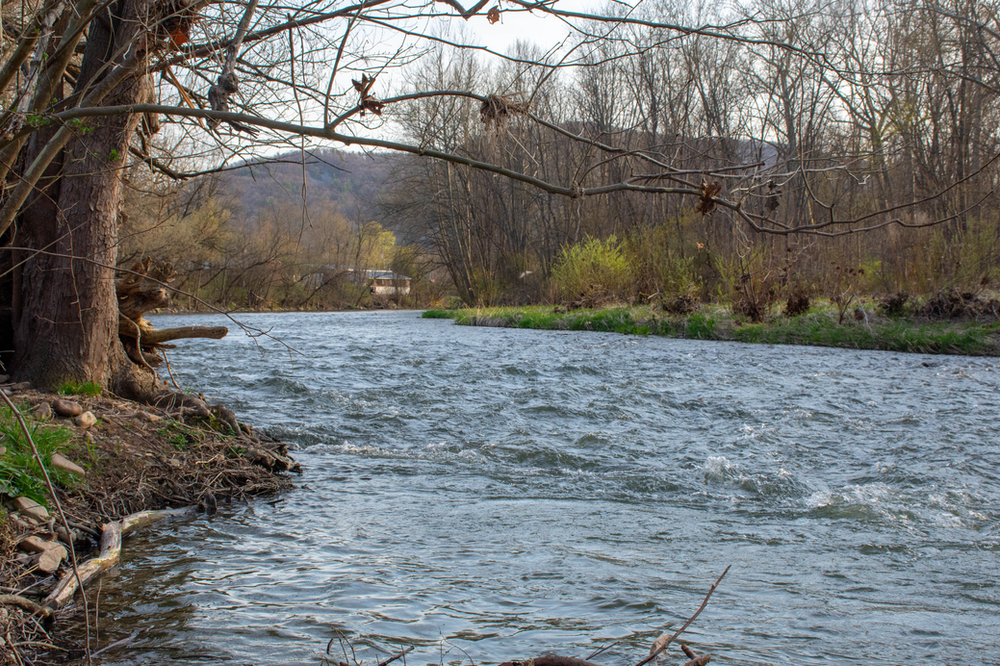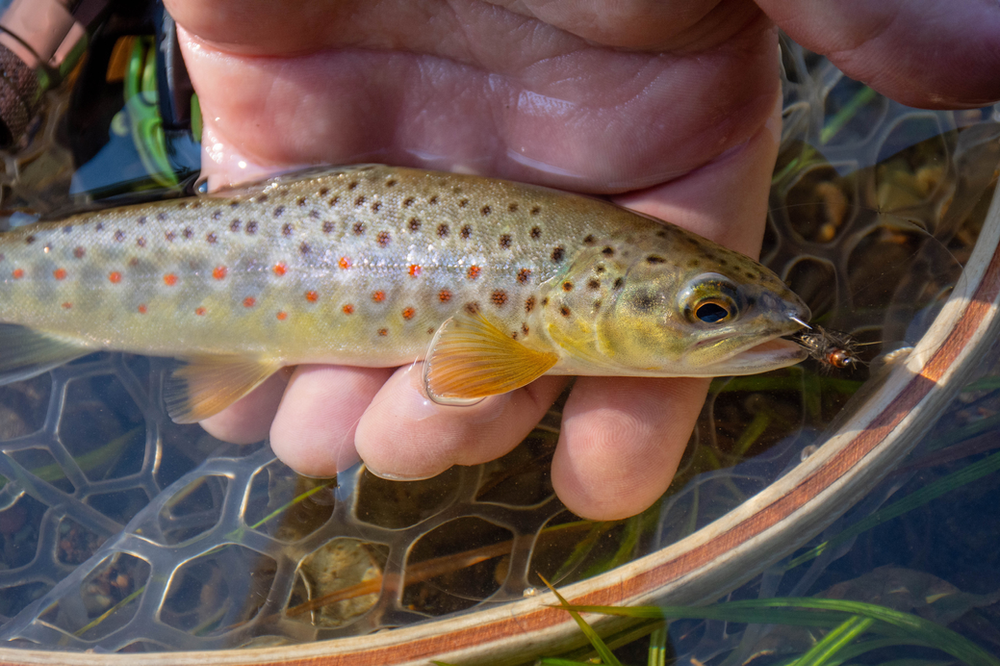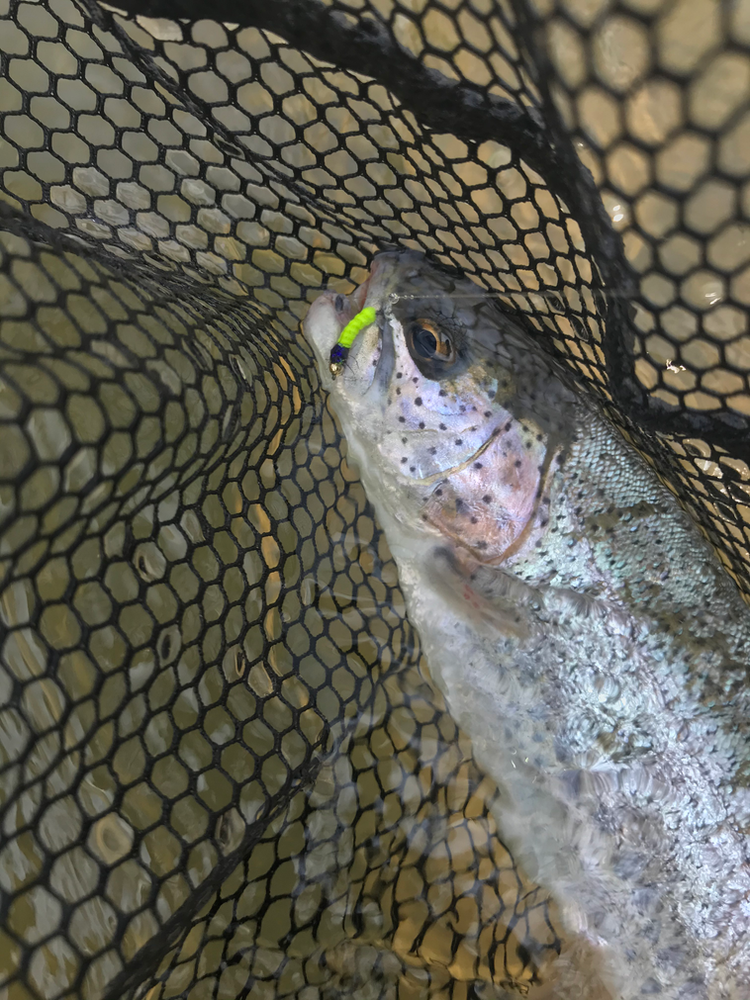Fly Fishing Bald Eagle Creek in Centre County

On a business trip to State College earlier this spring, I had only two hours of free time and decided it should be spent fly fishing on Bald Eagle Creek in Centre County. Not to be confused with the nearby stream of the same name, this Bald Eagle Creek is a 55-mile tributary of the West Branch Susquehanna River.
For reference, the other Bald Eagle Creek is a tributary of the Little Juniata River and is sometimes referred to as Little Bald Eagle Creek. Oddly enough, the headwaters of both Bald Eagles can be found within 20 yards of each other, emerging from the same patch of swamp, but one flows north while the other heads south. The Bald Eagle I fished is the one that flows north to join the West Branch Susquehanna River near Lock Haven, and it is the more significant trout stream for fly anglers.
Stocked Class A Trout Stream
This Bald Eagle Creek has the distinction of being a Class A stream that is also stocked with trout. The Class A section begins at the confluence of Spring Creek and extends through the back water of Sayers Dam. This section was recently the subject of an anglers survey to determine how to manage this stream in the future, and the results were pretty amazing.
The survey began on April 3, 2021. I’m proud to say I was among the anglers surveyed that first month for the study. I’d had a good day, landing a dozen or so stocked rainbows and losing a substantial wild brown. As I was walking back to the truck, the fish warden handed me a clipboard with the survey and I documented my day.
The survey ran until Labor Day, and during that time, an estimated 13,757 angler hours were documented, with over 9,000 of them recorded in April and May. During that time, approximately 12,306 rainbow trout were caught, which is 2.75 times more fish than were actually stocked in the Class A section. Although this indicates that stocked fish were caught multiple times, I wonder how many of those fish also moved down into section 6 from sections upstream from Milesburg that are also stocked. Upstream from Milesburg, Bald Eagle Creek is considered little more than marginal trout water that gets really skinny during the summer months.
Mark Nale, a fellow member of the PA Outdoor Writers Association, wrote an interesting article on this survey in the June 25, 2023, edition of Centre Daily Times (which you can read here on Yahoo! Sports). In his piece, Nale writes, “However, many (trout) were also creeled during the course of the season. The survey revealed that 2,579 rainbow trout were harvested by anglers, indicating that approximately 57% of the stocked rainbows were harvested.
“During the 2021 survey, anglers caught an estimated 8,640 wild brown trout on section 6 of Bald Eagle Creek, and 1,210 were harvested. A large portion of the wild brown trout harvested measured 14 inches or longer.”

Bald Eagle Creek is a Class A stream that is also stocked. “No-kill” regulations on brown trout are aimed at increasing brown trout populations throughout the stream and will hopefully lead to the complete cessation of stocking in this stretch.
The Bald Eagle Creek Class A is approximately 5.72 miles long.
While completing the survey, I asked the fish warden if many wild browns had been caught so far that April. He said no, most of the trout caught had been stocked rainbows. He also noted that, historically, most of the browns were caught later in the summer, after spring fishing pressure died down — according to creel checks he had done in the past, at least.
With a naturally reproducing population of brown trout, it’s a shame to even stock fish in Bald Eagle Creek. And yet, I understand the reasoning. Because this is a high use stream, the PA Fish and Boat Commission hopes these stocked fish will alleviate the pressure on the wild trout and satisfy those anglers who still enjoy keeping a few fish for dinner.
One of the new proposed rule changes, in fact, is to impose a no-kill regulation on brown trout in Bald Eagle Creek. Anglers may only creel rainbow trout. The idea is that this will allow the brown trout population to continue propagating.
I support this, and here’s why: so many anglers have no idea of the significance and value of a wild fish, and many more of them cannot tell the difference between a stocked brown and a wild brown. So perhaps this is a vital first step in the educational aspect of wild trout conservation. If this model is successful, perhaps someday this will lead to the complete cessation of stocking on Class A streams.
Before that can happen, though, I think we’d need to know the estimated biomass of Bald Eagle Creek and have a baseline for how angling pressure has impacted it. 8,640 wild browns caught on 5.72 miles of stream comes out to around 1,510 fish per mile. It would be important to know what overall percentage of the wild brown trout population that represents — I cannot locate any stream surveys for this section that might provide answers to this question. Also, does the stocking of rainbow trout draw attention to this stream and actually bring more anglers who might fish elsewhere if the stream were not stocked?
Running its Course
Bald Eagle Creek originates as a freestone stream and is considered marginal trout water until it reaches Milesburg, where it picks up Spring Creek. Water flows get pretty low throughout the upper sections during the summer months. Old US 220 parallels the stream all the way from just south of Port Matilda downstream to Milesburg, so access is pretty easy to find.
Approximately one mile of water, from 0.38 miles upstream of Steele Hollow Run to 0.48 miles downstream of Steele Hollow Run, is the state’s only All-Tackle Keystone Select Trout water. This section flows almost completely through the Soaring Eagle Wetland between Port Matilda and Julian. In fact, the best way to access this stretch is via the parking lot of the wetland at 6543 South Eagle Valley Road in Julian. All of the regular restrictions associated with Keystone Select Trout waters remain in place, with the only difference being that anglers can use the lure, bait, or fly of their choice. It’s a cool idea, and I appreciate the inclusivity behind it, but I hope this idea doesn’t become commonplace on all Keystone Select Trout waters or all streams with sections designated Delayed Harvest Artificial Lures Only.
Many of Bald Eagle Creek’s small tributaries can be found on the list of Pennsylvania’s Class A streams: Oliver Run, Laurel Run, Dicks Run, Wallace Run, Holt Run. And that’s not including the two most famous tributaries, Spring Creek and Fishing Creek. (Incidentally, Fishing Creek is also a Class A that is stocked and under consideration for the same “no-kill” regulation for brown trout.)
Below Milesburg, I’ve come to think of Bald Eagle Creek as really just an extension of Spring Creek. When I was there recently, Bald Eagle above the confluence looked pitiful, nothing more than a trickle, but downstream it was beautiful and full of water. From there downstream, I’d estimate that Spring Creek accounts for about two-thirds of Bald Eagle Creek’s total volume. The wild browns there can certainly be as difficult to catch as some Spring Creek trout.
Unfortunately, Fishing Creek doesn’t enter Bald Eagle Creek until well downstream of Sayers Dam, so its influence is minimal. By then, Bald Eagle Creek is home to the traditional warmwater species, although I’ve read that an occasional trout does show up at unlikely times below the dam.
Oddly enough, I’ve read that the hatches are better and more diverse in the marginal water upstream of Milesburg. But I will say this, downstream of the Spring Creek confluence, I witnessed a Grannom hatch that was nothing short of phenomenal.

The stocking of rainbow trout does make the fishing substantially easier on Bald Eagle Creek compared to the fishing for wild browns on Spring Creek.
Good Days and Bad Days
My first trip to Bald Eagle Creek in 2021 was a thing of beauty. The massive Grannom hatch I just mentioned came off practically all day. It was the most absurd and wonderful hatch of insects I’ve ever seen, and yet very few trout rose for them, which is typical of any type of caddis hatch. I did, however, have an excellent day fishing caddis pupa.
On that visit, I also got burned in the fast current by a heavy wild brown. It hit like a freight train and quickly left the station! It headed downstream before I could do anything to stop it and snapped me off. In early spring, Bald Eagle Creek is substantial water downstream of its confluence with Spring Creek. It has lots of deep pools and runs and heavy riffles. Once a big trout gets out into that swift current, it’s awfully hard to convince it to come back.
Other trips to Bald Eagle Creek have been much like the first. Pleasant. Lots of water. Lots of fish. Overall, very enjoyable experiences. This most recent trip, though, was another story. Lack of rain made the stream look more like an August fishery than a late-spring oasis. Even still, it didn’t take long to get into fish.
The first trout I hooked was a spunky rainbow that quickly threw the hook. I should’ve taken that as a bad omen and turned around and went home. It would’ve saved me a lot of frustration if I had, because over the next two hours, I proceeded to lose a total of 15 flies to snags! (In my defense, I caught 8 fish!) Let me explain.
The fish were hitting so light that I was having a hard time hooking them. The pool that seemed to have the most trout was long and narrow and fairly deep, so it took a little longer line to get deep enough to get to the bottom. Every time I missed a fish, my line shot up out of the water and was just long enough to reach the tree overhead and behind me. This happened six times while I was there, and since I use a two-fly rig, my loss rate proved exceptional!
But I was getting hits and hooking just enough of the bastards to keep running the gauntlet. At first, it was no big deal. And then I opened my fly box and realized that all of the flies I’d tied for this trip were now depleted. It was a sobering experience.
Finally, I move downstream to a bigger, and more open, pool. For whatever reason, I tied on a three fly rig, which I used with great success on Kettle Creek earlier this year. I didn’t think it would be a problem, until I snagged an underwater pipe that was extending out into the pool from the opposite bank. I lost all three flies as well as the strike indicator I had clipped on for fishing that pool. However, I did pick up a 12-inch wild brown in that pool. In a handful of visits to Bald Eagle Creek, that was only the third (but definitely the nicest) wild brown I’d actually landed, so that was a win.
I picked up a couple more trout as I was heading downstream to go back to the truck. I’d tied on a Woolly Bugger and kept lobbing it out there as I waded downstream, just letting it swing as I navigated the rocks and not paying a lot of attention to it. Two trout had pity and hammered the fly. I was so disgusted, though, that I didn’t even turn on my GoPro for either catch. The numbers seemed almost impossible: 15 flies lost in only two hours! That has to be some kind of record!
I was feeling pretty dejected over the whole thing. It wasn’t until later that it wore off and I reminded myself that I did catch eight trout in only two hours, including a wild brown. But in the moment, I was frustrated that I’d spent the better part of those two hours on Bald Eagle Creek just tying on new tippet and flies.
As I was working downstream, two guys were walking up the opposite bank toward where I’d been fishing. Our eyes met. “You all right?” one of them asked.
He said it in the same tone someone uses when they’re inquiring about someone else’s mental health. Can he really tell just by looking at me? I wondered. And then I realized he actually asked “Doing all right?” and was referring to the fishing and not really asking if I was about to do something drastic.
I didn’t say anything but nodded that yes, I was doing all right. It was a beautiful, warm day and I was catching fish on Bald Eagle Creek. I was doing just fine.
Did You Enjoy This Post About Bald Eagle Creek?
Stay up to date with the Dark Skies Fly Fishing monthly newsletter for free and receive the latest product reviews, fly fishing news, tricks, tips, and techniques, stream reports, as well as updates on new flies added to the Online Store and exclusive discounts!
Sign Up Now
Thanks, Ralph, for clarifying the difference between the two Bald Eagle Creeks in the same region. This confused me for years as I crossed Bald Eagle Creek in Tyrone and Bald Eagle Creek in Milesburg! Who is responsible for for naming these streams? Lol!
I remember reading your text when you lost fifteen flies in the matter of a few hours. It struck me just as funny reading it months later in this article and I was able to laugh at your expense. Again. However, I will also say that I feel for you. That’s a lot of flies to lose over several outings let alone a couple of hours! I’m giving you the record on most flies lost in a short period of time!
This article makes me want to give Bald Eagle Creek a try. I have fished Spring Creek a lot over the years. More times that I can count. However, during all of those visits to Spring, I never ventured to give BEC a try. I absolutely need to sooner than later.
Justin
Hey Justin, thanks for reading! I think the person who named streams in PA was either constantly drunk or had a very poor memory. How else can we explain a Pine Creek or Spring Creek in (almost) every county??
I’m glad you got a laugh at my expense…again. I remember when I first texted you about that right after it happened. I felt ashamed but at the same time it was way too funny not to share!
At this juncture, I feel that you should be proud of the impressive feat! I mean, when an angler does not lose flies regularly then this suggests they are not fishing hard enough by placing their presentations into gnarly stuff where fish live. Ok, fifteen flies is a lot! But, you were clearly working very hard to put them where the fish were. And, you caught trout that day. The loss of fifteen flies is a badge of fishing honor!